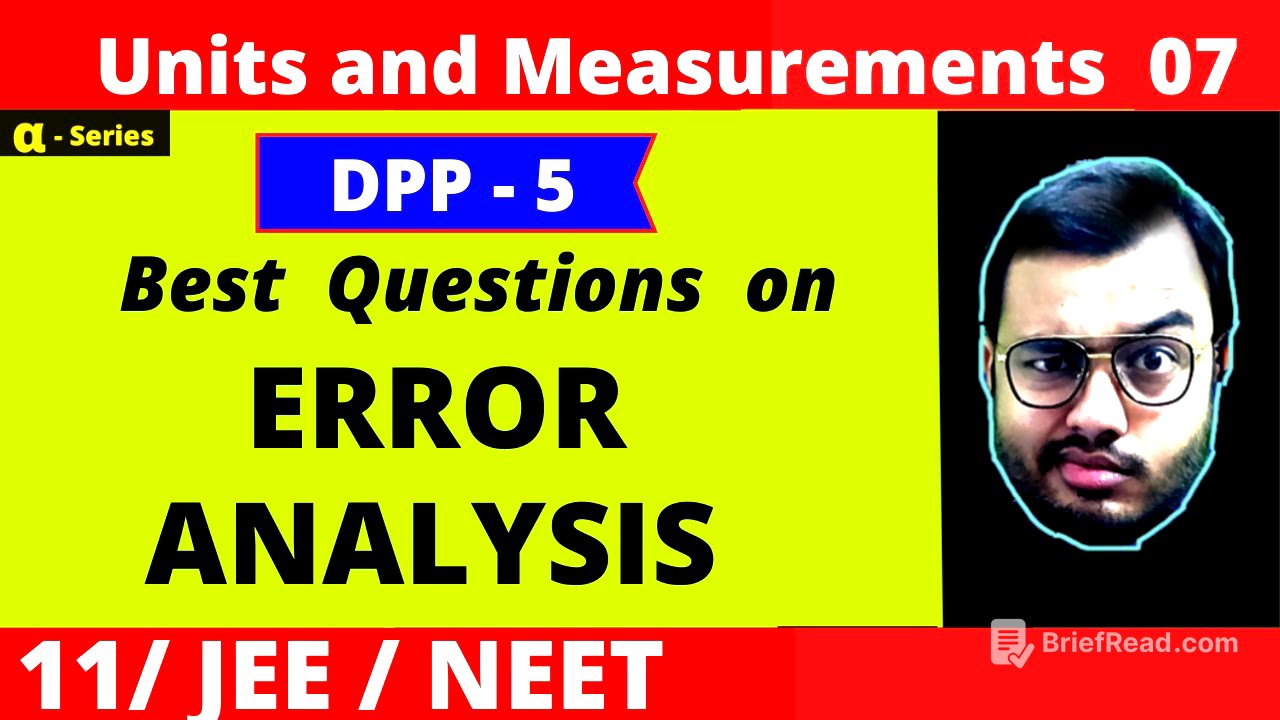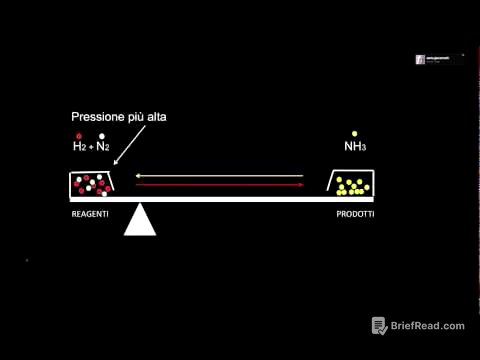TLDR;
This video features Alakh Pandey from Physics Wallah, who tackles error analysis questions relevant to IIT JEE Main and Advanced exams. He emphasises the importance of attempting the questions before looking at the solutions and highlights the source of the questions as Daily Practice Problems (DPP) from the Physics Wallah website. The lecture covers percentage error calculations, equivalent resistance with error, error propagation in measurements, and IIT JEE problems involving simple pendulums and time period measurements.
- Percentage error calculations
- Equivalent resistance with error
- Error propagation in measurements
- IIT JEE problems
Introduction [0:00]
Alakh Pandey welcomes students to a lecture on Unit and Measurement, specifically focusing on error analysis questions for IIT JEE Main and Advanced levels. He encourages students to attempt the questions themselves before reviewing the solutions. The questions are sourced from Daily Practice Problems (DPP) available on the Physics Wallah website.
Percentage Error in Volume of a Sphere [2:34]
The lecture begins with a question about calculating the percentage error in the volume of a sphere, given a 1% error in its radius. The formula for the volume of a sphere, V = (4/3)πr³, is used. Since 4/3 and π are constants, the error in volume (ΔV/V) is three times the error in the radius (ΔR/R). Therefore, a 1% error in the radius results in a 3% error in the volume.
Equivalent Resistance with Percentage Error [4:37]
Next, the problem involves finding the total resistance of two resistors in a parallel combination, along with the possible percentage error. The values of the resistors are R1 = 5.0 ± 0.2 ohms and R2 = 10.0 ± 0.1 ohms. The formula for parallel resistance is 1/Requivalent = 1/R1 + 1/R2. The lecture explains that direct addition of errors is only applicable for quantities added or subtracted, not for complex formulas like this. The approach involves transforming the formula to isolate R equivalent and then applying error propagation rules.
Error Propagation in Parallel Resistance Calculation [6:58]
The calculation continues by expressing R equivalent as R1R2 / (R1 + R2). The percentage error in R equivalent is then calculated using the formula: ΔR/R = ΔR1/R1 + ΔR2/R2 + Δ(R1+R2)/(R1+R2). The values are plugged in, and the percentage error is found to be approximately 7%. The actual value of R equivalent is calculated as 3.3 ohms, making the final answer 3.3 ohms with a 7% error. The lecture emphasises that when quantities are added or subtracted, absolute errors are added, but for multiplication and division, percentage errors are used.
Combining Lengths with Least Count Error [12:59]
This section addresses a problem where two rods of lengths 2.53 cm and 1.27 cm are joined end-to-end. The least count of the measuring instrument is 0.01 cm. The combined length is simply the sum of the two lengths, which is 3.80 cm. The lecture explains that the least count of the measuring instrument is the absolute error. When adding measurements, the errors also add up. Therefore, the error in the combined length is 0.01 cm + 0.01 cm = 0.02 cm. The final answer is 3.80 ± 0.02 cm.
IIT JEE Problem on Simple Pendulum [23:29]
Alakh solves an IIT JEE 2019 problem involving a simple pendulum. The time for 20 oscillations is measured using a stopwatch with a least count of 1 second, and the mean value is 30 seconds. The length of the pendulum is measured as 55 cm with a least count of 1 mm (0.1 cm). The question asks for the percentage error in the determination of g (acceleration due to gravity).
Error Calculation in Pendulum Experiment [27:22]
The formula T = 2π√(L/g) is used, which leads to g = 4π²L/T². The percentage error in g is given by Δg/g = ΔL/L + 2(ΔT/T). A common mistake is using the total time for 20 oscillations as T, but T should be the time period for one oscillation. The correct approach involves dividing the total time (30 seconds) by the number of oscillations (20) to get T = 1.5 seconds. The error in time, ΔT, is the least count of the watch divided by the number of oscillations, i.e., 1 second / 20 = 0.05 seconds. The percentage error in g is then calculated using these corrected values.
JEE Main 2018 Problem on Pendulum Experiment [35:35]
This section covers a JEE Main 2018 question. The mean value of the length is 55 cm with 1 mm accuracy, and the time for 100 oscillations is 90 seconds using a wristwatch of 1-second resolution. The percentage error in determining g is to be found. The same formula, g = 4π²L/T², is used, and the percentage error is calculated as Δg/g = ΔL/L + 2(ΔT/T). The error in length, ΔL, is 1 mm (0.1 cm), and the error in time, ΔT, is 1 second for 100 oscillations, so for one oscillation, it's 1/100 seconds.
JEE Main 2018 Table-Based Problem [42:53]
This section discusses a JEE Main 2018 problem presented in a table format. Three students perform an experiment to measure g using a simple pendulum with different lengths and numbers of oscillations. The least count for length is 0.1 cm, and for time, it's 0.1 seconds. The task is to determine which student has the minimum error in the measurement of g.
Error Analysis for Multiple Students [46:54]
The percentage error in g is calculated for each student using the formula Δg/g = ΔL/L + 2(ΔT/T). The values of ΔL, L, ΔT, and T are extracted from the table for each student. By comparing the values, it is determined that Student 1 has the minimum error.
JEE 2010 Problem on Pendulum with Zero Length Error [53:58]
This section addresses a JEE 2010 problem where the length of a simple pendulum is exactly 1 metre, meaning there is no error in length measurement. A stopwatch with a least count of 1 second is used, and the time for 20 oscillations is 40 seconds. The question involves finding the error in measuring the time period and the percentage error in determining g.
Error Calculation with Zero Length Error [57:15]
Since the length is measured exactly, ΔL = 0. The time period T is 40 seconds / 20 oscillations = 2 seconds. The error in time, ΔT, is 1 second / 20 oscillations = 0.05 seconds. The percentage error in g is calculated as Δg/g = 2(ΔT/T) = 2(0.05/2) = 0.05 or 5%.
JEE Advanced 2016 Problem on Spring-Mass System [1:00:30]
This section covers a JEE Advanced 2016 problem involving a spring-mass system. The time period is given by T = 2π√( (R-r) / 5g ). The values of R and r are given with their respective errors. The task is to find the percentage error in R and T and then determine the percentage error in g.
Error Propagation in Spring-Mass System [1:03:39]
The percentage error in R is calculated as (ΔR/R) * 100 = (1 mm / 60 mm) * 100 ≈ 1.7%. The time period is measured five times, and the average time period is calculated. The absolute error in the time period is calculated using the median absolute deviation method. The percentage error in g is then calculated using the formula derived from the time period equation.
JEE Advanced 2017 Problem on Depth Measurement [1:13:39]
This final section presents a JEE Advanced 2017 problem where the depth of a well is measured using the time it takes for a stone to drop and the sound to return. The depth is calculated using the formula L = gT²/2, where T is the total time. The task is to find the fractional error in the measurement of the depth.
Error Analysis in Depth Measurement [1:18:18]
The total time T is the sum of the time it takes for the stone to fall (T1) and the time it takes for the sound to travel back (T2). The error in the total time is the sum of the errors in T1 and T2. The fractional error in the depth is then calculated using the formula ΔL/L = ΔT/T.









